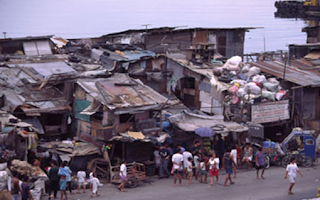Etching out a life on Smokey Mountain CNN Article
I knew it was a rubbish dump; a place where tens of thousands of people once scavenged for their livelihood - an occupation adopted by so many of the world's poor who live below the poverty line. Here in the Philippines, that equates to almost half the population.
As I began to research, images of people stooping to such humiliating lows to put food in their mouths appeared online. But considering the landfill had closed in 1990, and the community moved to housing commission next door, I just presumed the face of poverty at Smokey Mountain had become more dignified.
It's this looming mass of decomposed rubbish, standing more than 20 meters high. From a distance it looks like an enormous mound of Earth, almost of equal height to the towers that stand next to it, but on closer inspection you can see the layers of plastic bags, tires and bottles all squashed together -- the remains of 50 years of Manila's trash.
I see this young girl covered head to toe in dirt carrying up a large bottle of water -- like the one that belongs in an office building. Her clothes are ripped, her ratty plastic sandals - three sizes too big - her hair, completely disheveled and soot covers her face as if she'd been working in a coal mine.
With the water bottle resting on her shoulder she gives me a huge smile, inviting me to follow. In tow are two little girls, roughly the same age, laughing... amused that this white woman with blonde hair, carrying a camera wants to enter their world.
We get to the top, hands covered in dirt and mangy dogs race up barking viciously. The three little girls are oblivious to these creatures that would definitely give you rabies if their teeth actually sunk into your flesh. Chickens scratch in the dirt and decomposed rubbish that's strewn across this lunar landscape.
Several humpy-type structures are standing in the scrubby vegetation. I'm shocked to discover that people actually live up here. I follow the girls to their home. Or at least what they call home. Bits of plastic and wooden sheeting to keep out the elements; a piece of corrugated iron attached for a roof and a timber palate with a mat on top, that keeps them an inch above the earth while they sleep.
I ask the name of the girl carrying the water. She responds in perfect English, her name is Rhea Rebadolla and she says she is 11 years old. She introduces me to her 8-year-old sister, Felomina, who doesn't leave her side, and her 10-year-old friend and neighbor, Noreen Grace.
Much to my surprise, they all speak English having attended the local school up until the end of last year. I ask why they don't go anymore and they explain quite simply they can't afford to. I photograph them and they ask to see the photos, laughing and giggling like little school girls. I ask after their parents and find a man who knows the girls. He says their parents are out scavenging for rubbish. They move around, depending on where the work is and recently pulled the girls out of school because they couldn't afford to pay the school fees.
Further enquiries reveal that the education system in that community, at the bottom of the landfill, is free. I wonder whether the parents have pulled them out of class to make them work.
From the top of the landfill you can see sprawling Manila. The high-rises of the city's financial district in the distance -- through the haze of the metropolis you can see the mountain range hugging the capital. A shipping terminal backs on to the landfill. Huge tankers sit in the harbor waiting to load and unload.
There are signs of money and wealth everywhere, but here on Smokey Mountain, on top of this landfill, there are just three little girls who will never know what any of that means.
Rhea takes my hand in hers, as if it's the most natural thing in the world. She shows me around her slum of an existence as the sun sinks into the ocean and dusk begins to fall. I ask her to follow me to the car. What can I do to help improve this 11-year-old's life, other than take her away, out of her world, give her a bath, an education, a future?
Instead we give her and her friends some money, wishing, hoping this was their ticket out of the cycle of poverty.
"Etching out a life on Smokey Mountain" and write a reflection on the issues referred to in the article:
"Etching out a life on Smokey Mountain" and write a reflection on the issues referred to in the article:
Smokey Mountain is a truly famous landmark, a landmark where thousands of people lie in poverty. Decomposed rubbish, stands more than 20 metres high, there is no man made paths just a rope dangling from the top and rubbish trodden path. Young children suffer from lack of hygiene; the risk of transmitting rabies is at a high rate. A house is considered bits of plastic and wooden materials, people live up on this mountain. The girls don’t have access to education anymore, simply as they cannot afford it, and their parents for a living are out scavenging for rubbish. There are still questions surrounding if parents force children to work instead of attending school. This is the cycle of poverty, something one can sometimes not escape.



No comments:
Post a Comment